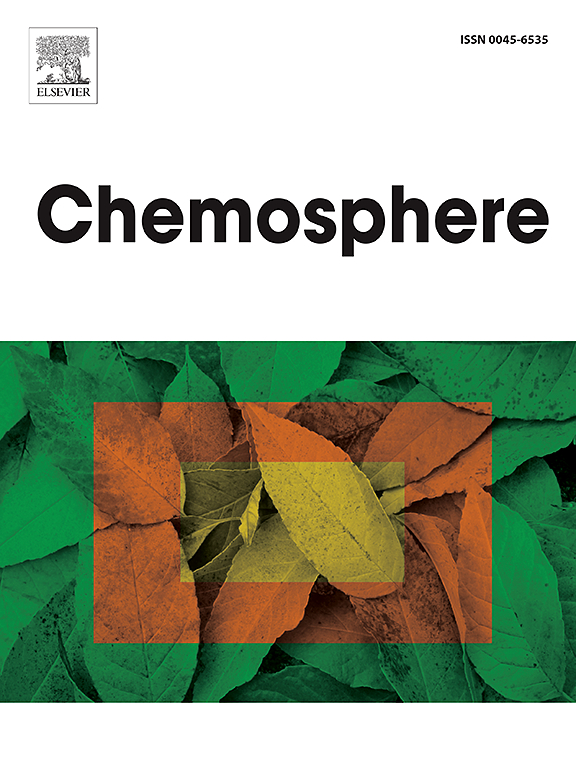Hotspots and dynamics of dissolved thallium species at oxic-anoxic interfaces in flooded soils
IF 8.1
2区 环境科学与生态学
Q1 ENVIRONMENTAL SCIENCES
引用次数: 0
Abstract
Thallium (Tl) is highly toxic, predominantly existing in its monovalent Tl(I) state in the environment. However, the redox “niche” of both dissolved trivalent and monovalent Tl(III/I) remain under-studied in typical oxic-anoxic interfaces. Here, we hypothesize that the behavior of dissolved Tl is constrained by manganese (Mn), iron (Fe), and sulfur (S) species. Dissolved Tl(III/I) profiles and associated redox species Fe(III/II), Mn(II), and S(VI/II) were quantified spatially (a resolution of 1.8 mm) and temporally (diurnal and seasonal) at the rice rhizosphere and the soil-water interface (SWI). The results showed that hotspots of both dissolved Tl(III) and Tl(I) were identified at the rhizosphere and SWI, with redox niche closely following Mn-reducing conditions and also supporting an oxidation mechanism from Tl(I) to Tl(III). Supporting evidence were that newly formed ferromanganese plaque strongly retained the dissolved Tl, while dissolved Tl(III/I) hotspots coincided with moderate Mn-reducing conditions in both SWI and rhizosphere. Dissolved Tl(III) prevailed at higher ratios of dissolved Fe(III)-to-Fe(II). Additionally, porewater Tl(III/I) and copper (Cu(II)) showed similar behaviors at different temporospatial scales, likely due to shared redox constraints. Collectively, the evidence suggests that Mn oxides serve as both sources and sinks of dissolved Tl(III/I) at redox fluctuated areas. Tl mobility was greatly constrained in both more reduced (Fe and S) and more oxidized conditions, highlighting implications for developing effective remediation strategies.

铊(Tl)毒性很强,在环境中主要以一价 Tl(I)态存在。然而,在典型的缺氧-缺氧界面中,对溶解的三价铊和一价铊(III/I)的氧化还原 "生态位 "研究仍然不足。在此,我们假设溶解态 Tl 的行为受到锰(Mn)、铁(Fe)和硫(S)物种的制约。我们对水稻根圈和土壤-水界面(SWI)的溶解态 Tl(III/I)剖面及相关氧化还原物种 Fe(III/II)、Mn(II)和 S(VI/II)进行了空间(分辨率为 1.8 毫米)和时间(昼夜和季节性)定量分析。结果表明,在根瘤菌层和土壤-水界面发现了溶解态 Tl(III)和 Tl(I)的热点,其氧化还原位点与锰还原条件密切相关,也支持从 Tl(I)到 Tl(III)的氧化机制。佐证是,新形成的铁锰斑块强烈地保留了溶解的 Tl,而溶解的 Tl(III/I) 热点与 SWI 和根瘤层的中度锰还原条件相吻合。溶解铁(III)与铁(II)的比率越高,溶解态 Tl(III)越多。此外,孔隙水 Tl(III/I) 和铜(Cu(II))在不同的时空尺度上表现出相似的行为,这可能是由于共同的氧化还原约束。总之,这些证据表明,氧化锰在氧化还原波动区域既是溶解 Tl(III/I) 的源,也是溶解 Tl(III/I) 的汇。在还原性(铁和锰)更强和氧化性更强的条件下,钛的移动性都受到很大限制,这对制定有效的修复策略具有重要意义。
本文章由计算机程序翻译,如有差异,请以英文原文为准。
求助全文
约1分钟内获得全文
求助全文
来源期刊

Chemosphere
环境科学-环境科学
CiteScore
15.80
自引率
8.00%
发文量
4975
审稿时长
3.4 months
期刊介绍:
Chemosphere, being an international multidisciplinary journal, is dedicated to publishing original communications and review articles on chemicals in the environment. The scope covers a wide range of topics, including the identification, quantification, behavior, fate, toxicology, treatment, and remediation of chemicals in the bio-, hydro-, litho-, and atmosphere, ensuring the broad dissemination of research in this field.
 求助内容:
求助内容: 应助结果提醒方式:
应助结果提醒方式:


